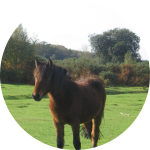|
Horse Stall contains all types of information for Horse Lovers.
There are a number of products branded horse gifts and products.
All gifts have a unique horse design that horse lovers and pony
owners will appreciate. Branded items include: t-shirts, sweatshirts,
sneakers, posters, skateboards, mouse pads, stickers, bumper stickers,
buttons, mugs, tote bags, invitations, greeting cards, neckties,
postcards, posters, prints and much more!
Horse Articles :: Horse Dentistry
Horse Dentistry
|
|
A good equine dentist should always aim to provide ethical
treatments that work towards improving the health, welfare,
future comfort and performance of the horse.
The anatomy of the horses head has evolved for the primary
purpose of eating. The gradual elongation of the head during
evolution allowed individual teeth to become larger and stronger.
The horse's lower jaw is narrower than the upper jaw and allows
for the circular movement involved in the chewing process
(mastication), where the top and bottom teeth are ground against
each other to grind the food.
The Temporomandibular joint is the most frequently used joint
in the horse's body. This joint is made up of the condyle
processes of the mandibles and the temporal bones.
This joint can easily become painful if there is uneven balance
within the mouth.
There are many reasons why horses may need the help of a dentist,
many of which can be resolved with investigation and treatment.
It is always better to prevent an uncomfortable situation
for the horse from becoming a more serious problem. There
are signs that the horse will portray that a conscientious
owner can recognise.
-Changes in their eating habits
-Dropping their feed as they eat
-Washing their feed in their water before eating
-Holding their head to the side
-Unpleasant breath
-A swollen face
-Rolling their feed into a ball then dropping it
-Weight loss
-Unable to keep weight on
Equine dentists that treat your horse should:
-Establish a treatment plan for your horse
-Remove the build up of sharp enamel points on cheek teeth
-Remove hooks and ramps
-Correct minor waves and overgrowths
-Re-establish correct cheek tooth table angles
-Re-establishment of proper molar occlusion
-Re-establishment of proper lateral excursion
-Re-establishment of proper anterior/posterior function
-Re-establishment of proper incisor tooth angles
After completion of treatment there should be no evidence
of trauma due to it and the owner should be informed of the
recommended schedule of routine maintenance. Every effort
should be made to avoid injury to the horse during procedures
If the dentist is unable to complete their treatment or the
need for future treatment is required, the owner should be
informed.
Why do horses teeth get sharp?
Horses and other equids have hypsodont teeth. These are teeth
with a limited growth period but constant eruption throughout
the animal's life. This means that it is the grinding together
of cheek teeth during mastication that keeps teeth worn to
the optimum level. The anatomy of the upper and lower jaw
contributes to cheek teeth forming sharp edges.
If teeth are even slightly unevenly worn, the problem gradually
becomes more serious and will not correct itself.
Performance
Does your horse ever;
-Get head shy?
-Head toss?
-Rear?
-Become unsettled when ridden?
-Not perform to their best?
All these symptoms are typical in the horse with dental problems.
Uneven tooth wear can cause pain and a cause the horses head
to 'lock up' and stop the natural, very important Anterior
/ Posterior movement within the head. As the horses head lifts
up his lower law pulls back, as it is lowered, it moves forward.
Locking up occurs due to one tooth erupting more than the
others in the arcade, causing the occluding tooth to erupt
less. This prevents the natural movement of the head and prevents
natural free flowing movement throughout the horse, reducing
the horse's ability to perform!!
Pain
Skilled placement of instruments will ensure a pain free treatment.
Horse's teeth do not have the same enervation as human, crowned
teeth.
How often should teeth be checked?
Horses should be checked as foals, to ensure the correct tooth
development and formation within the mouth. Periodically after
this, twice annually as a guide, but dependant on the dentist's
advice can be left longer or seen to more frequently. A problem
is better caught early and prevented from getting worse, rather
than allowed to escalate into something potentially more painful
and costly to fix.
It is a good idea if the owner can perform basic checks to
monitor the horses teeth, in order to spot any problems early,
the dentist should show owners how to do this.
Veterinarians v's Dentists
A recent survey of Veterinary colleges showed over 80% of
Vet schools have less than 3 hours of training in equine dentistry,
incorporating very little clinical practice. *
Everyone has an opinion; it may just be that the vet's opinion
may be invalid due to their lack of experience. It is important
to note that there are Vets's that seek out extra training
in Horse Dentistry and are very competent in their work.
There are dentists that also treat horses, who have had very
little or no training. It is in the owners and horses best
interest to check the knowledge of anyone treating your horse,
and ensure you are completely happy before commencing treatment.
(*Refer to World Wide Association of Equine Dentistry)
About the Author
Tammy is a avid horse rider who likes to advertise the correct
ways to be looking after horses. Tammy works part time for
Anything Equine online who specialise in Stable Rugs as well
as Equitech equestrian clothing and equipment in the UK.
|
|
|


